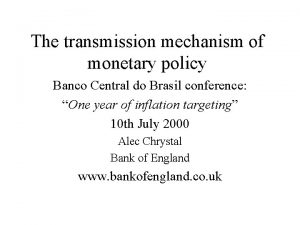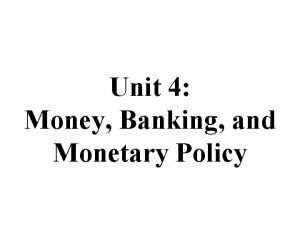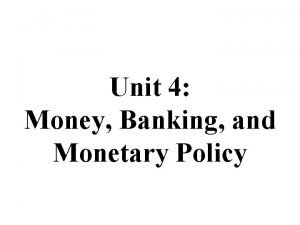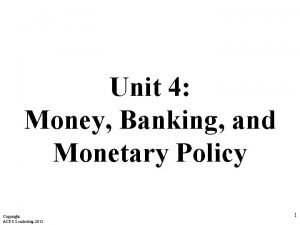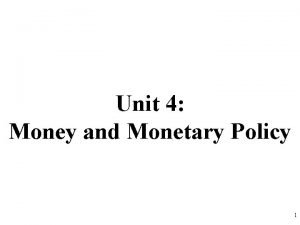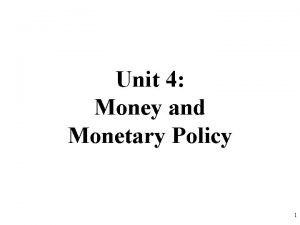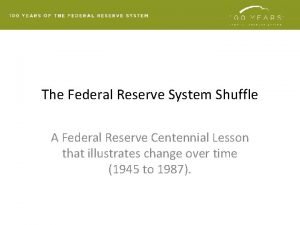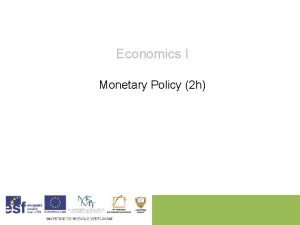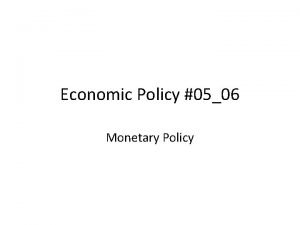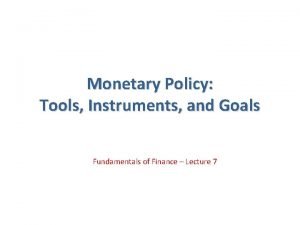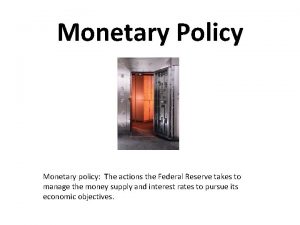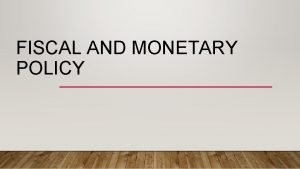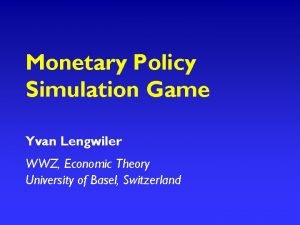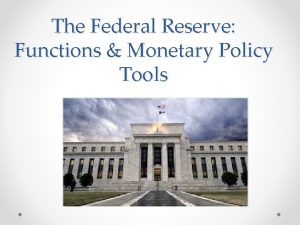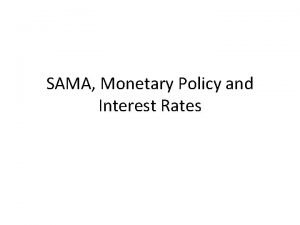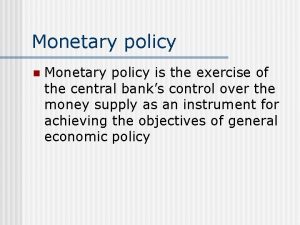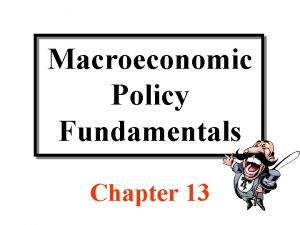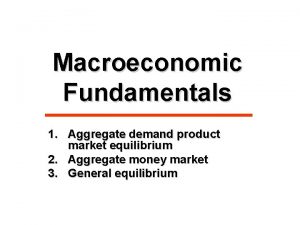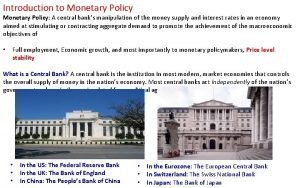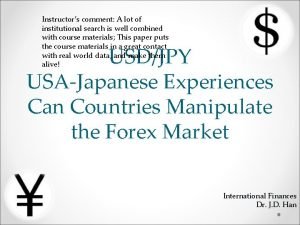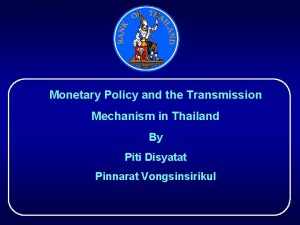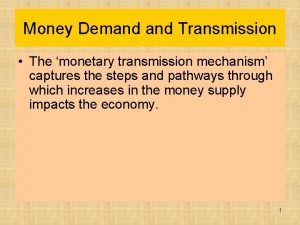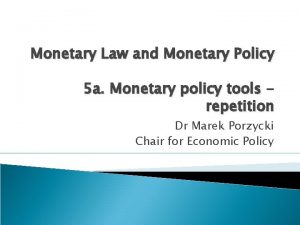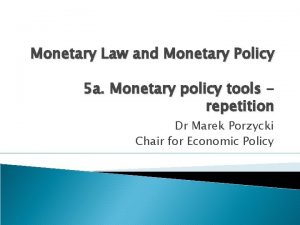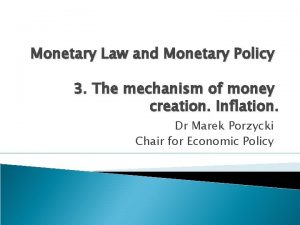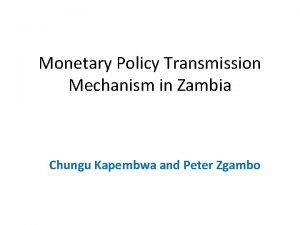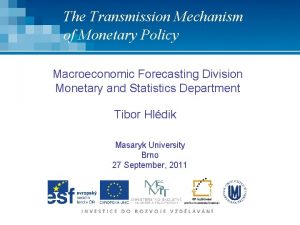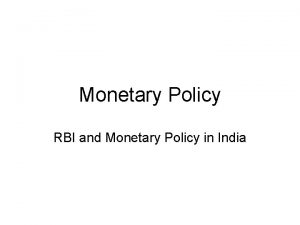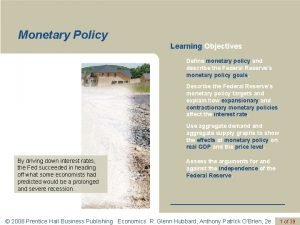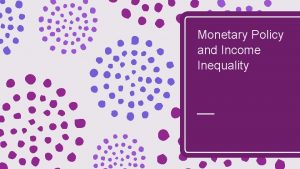Monetary Policy and the Transmission Mechanism in Thailand






























- Slides: 30

Monetary Policy and the Transmission Mechanism in Thailand By Piti Disyatat Pinnarat Vongsinsirikul

Motivation • Understanding transmission mechanism key to successful conduct of monetary policy – Time lag – Channels of transmission • Compare with evidence from other countries • How has the crisis affected monetary transmission?

Presentation Outline • The main channels of monetary transmission • Interest rate pass-through • Response of key macro-variables to monetary shocks • Relative importance of each channel • Summary and conclusion

Monetary Transmission Mechanism Transmission Channels S-T Interest Rate Central Bank OMO Interest Rate Credit Exchange Rate Asset Price Output and Inflation

Interest Rate Pass-Through To Retail Rates Methodologies 1. Dynamic Multiplier Model 2. Error Correction Model (ECM)

Pass Through of RP to 3 -Month Deposit Rate Methodology Period Impact Immediate 3 -Month 6 -Month Long-Run Multiplier Method 89 M 1 -95 M 12 0. 057 0. 402 0. 612 0. 7 89 M 1 -02 M 3 0. 059 0. 317 0. 399 0. 429 ECM Speed of Adjustment 89 M 1 -95 M 12 0. 5 0. 147 89 M 1 -02 M 3 0. 35 0. 07

Pass Through of RP to Minimum Lending Rate Methodology Period Impact Immediate 3 -Month 6 -Month Long-Run Multiplier Method 89 M 1 -95 M 12 0. 089 9. 328 0. 521 0. 558 89 M 1 -02 M 3 0. 041 0. 239 0. 356 0. 389 ECM Speed of Adjustment 89 M 1 -95 M 12 0. 4 0. 101 89 M 1 -02 M 3 0. 356 0. 08

International Comparison of MLR Pass-Through



Justification for Interest Rate Stickiness in Thailand • High switching cost during economic downturn and fewer alternative sources of funds • Credit rationing due to asymmetric information • High liquidity • Social pressure • Posted rate

Response to Monetary Shocks • Time lags • Channels of transmission

Methodology • Vector Autoregressions (VARs) analysis – Dynamic system of equations – Minimal assumption about structure of economy – Evidence for other countries readily available • RP 14 indicator of monetary policy • Sample: 1993 Q 1 to 2001 Q 4

Basic Model: GDP, CPI, RP 14: 2 Lags • U-shaped output response, maximum impact after 4 -5 quarters

Components of Aggregate Demand • Private Consumption • Investment • Export • Import


Channels of Monetary Transmission • Augment basic model with variable that represents each channel • Compare output response with and without the relevant channel operating

Bank Lending Channel • Heavy reliance on bank finance in Thailand Private credit to GDP ratio (average for 1995 -2000)

Bank Lending Model • GDP response larger • LOANS fall after 3 quarters • PRICE falls after 4 quarters

Bank Lending Channel

Credit intensity of production has fallen Re-estimate over 1993 Q 1 to 1999 Q 1: • Impact of RP 14 on GDP and LOANS larger • Impact of LOANS on GDP larger

Bank Lending Channel: 1993 Q 1 -1999 Q 1

Exchange Rate Channel

Asset Price Channel

Direct Interest Rate Channel

Summary Model

Conclusion Stylized Facts (In Response to a Tightening): 1. GDP displays U-shaped response, trough after 4 -5 quarters and dissipating after 11 quarters 2. GDP displays U-shaped response, trough after 4 -5 quarters and dissipating after 11 quarters 3. Investment most sensitive component of GDP

Conclusion (cont. ) • Transmission primarily through interest rate and bank lending channels • Role of banks declined in recent years - Lower interest rate pass-through - Weaker bank lending channel

Looking Forward • Bank health and corporate balance sheets • More sensitivity of retail rates • Wider share ownership • Greater access to credit: Financial Master Plan • Resolution of FIDF problems

Implications for Monetary Policy • Significant lags involved in monetary transmission • These lags change over time • Must be forward-looking – Rely on accurate forecasts – Constantly look out for structural changes in the economy
 What are open market operations
What are open market operations Transmission of monetary policy
Transmission of monetary policy Unit 4 money banking and monetary policy
Unit 4 money banking and monetary policy Unit 4 money banking and monetary policy
Unit 4 money banking and monetary policy Graphing monetary and fiscal policy interactions
Graphing monetary and fiscal policy interactions Unit 4 money and monetary policy
Unit 4 money and monetary policy Unit 4 money and monetary policy
Unit 4 money and monetary policy Unit 4 money and monetary policy
Unit 4 money and monetary policy Lesson quiz 16-1 monetary policy
Lesson quiz 16-1 monetary policy Objectives of monetary policy
Objectives of monetary policy Meaning of monetary
Meaning of monetary Types of monetary policy
Types of monetary policy What are the objectives of monetary policy
What are the objectives of monetary policy Objectives of monetary policy
Objectives of monetary policy Expansionary monetary policy
Expansionary monetary policy Three tools of monetary policy
Three tools of monetary policy Monetary policy summary
Monetary policy summary Fiscal vs monetary policy
Fiscal vs monetary policy Monetary policy simulation game
Monetary policy simulation game Monetary policy types
Monetary policy types Instruments of monetary policy
Instruments of monetary policy Demand pull inflation
Demand pull inflation Moral suasion central bank
Moral suasion central bank Monetary policy
Monetary policy Sama exchange rate
Sama exchange rate Instruments of monetary policy
Instruments of monetary policy Expansionary monetary policy flow chart
Expansionary monetary policy flow chart Expansionary policy
Expansionary policy Monetary policy
Monetary policy Fractional reserve banking
Fractional reserve banking Features of fiscal policy ppt
Features of fiscal policy ppt

